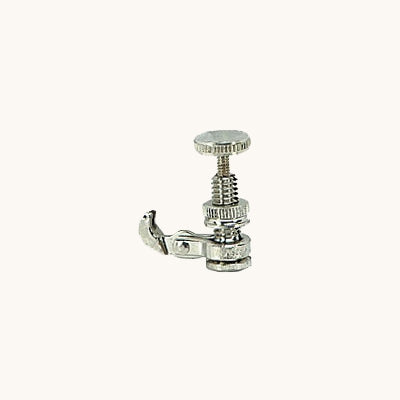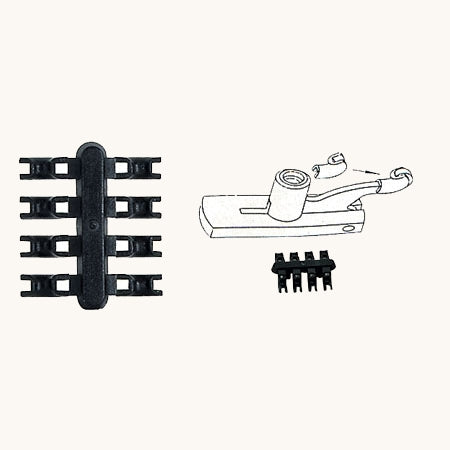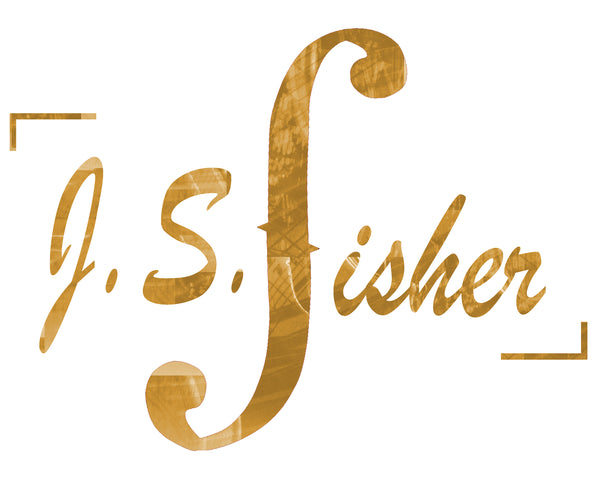There is a great deal of confusion around how we attach strings to the violin's tailpiece. For most G, D, and A strings, manufacturers attach a little brass "ball" to the end of the string. Being the creative types that we are, luthiers call this a ball-end type string. Truth be told, manufacturers have figured out that it's cheaper, or easier, to make a little metal ring, like a miniature doughnut, rather than a true ball-like sphere. So, nowadays, a "ball" end string end looks like this . . .

E strings, however, come in two major varieties. You can purchase a ball-end E string, as above. Or, you can purchase a loop-end E string. Why just the E? Because on a professional violin setup, only the E string is given a fine tuner. (The other strings being tuned at the pegs with the player's left hand, while the strings are bowed with the player's right hand, to achieve absolutely perfect fifths between the open strings.) And, fine tuners used to be designed only for loop-end strings. Like this . . .


The ball-end G, D and A strings are attached to the tailpiece by inserting them through the hole and wedging behind the little slot, designed to hold them in place once the string is under tension . . .


Why then the ball-end version of the E string? Well, because some players prefer not to use any fine tuners and therefore need to install the E string in the same manor as the G, D, and A - directly into the tailpiece. Other players prefer to use a fine tuner that is designed to take a ball-end string, like this . . .

And, finally, some tailpieces are designed with fine tuners built in, and are designed to take only ball-end strings, like this . . .


So, the key to buying the right type of E string, is to understand the type of tailpiece and/or fine tuner you have. And, to understand that the ball-end string is really a ball-end, even though you could argue that the doughnut at the end looks like a loop.
A Few Other Notes And Points of Confusion
- Some manufacturers, particularly Thomastik, have started making their new string sets with a removeable ball end. This is a nice idea, since it avoids the common scenario of players accidentally purchasing the wrong string. If you want to install it as loop, you just pop out and discard the ball. But, be aware that they are still making their older string sets in the old way. And, this comes with its own confusion since dealers will sometimes not indicate the E string end at all in their description, since it only comes in one version - the removeable ball. However, there are also some string sets that similarly have no description for the E string end, but because they are only made with a regular ball end. And, it can be hard to know which you're looking at, if the dealer doesn't specify. (To be clear, at J.S. Fisher Violins, we list all sets that come with a removeable ball end as removeable ball end, and regular ball-end strings as just ball end.)
- If purchasing gut strings, there is another point of confusion. Gut strings were originally sold with no ball or loop. Players learned to tie a knot in the end, which they then wedged into the tailpiece, just like a ball-end string. Some gut strings still come this way and are usually described as plain end strings. Some gut strings come with the knot already tied for you and are usually described as knot end strings. And, some gut strings come with a ball or loop end. Just remember, even though the knot in a knot end string has a little loop in it, it is not to be installed as a loop-end string - you should wedge the entire knot into the tailpiece, like a ball end string. And, if purchasing plain end strings, you'll need to know how to do the knot yourself.
- A note about the fragility of loop-end strings: The metal loop in a loop-end E string is somewhat fragile. And, loop-end fine tuners, even expensive ones, often have a bit of an angle or even a sharp edge to the post that holds the loop. Consequently, loop-end strings are notorious for breaking at the loop. (This is one of the reasons that they started making ball-end E strings.) A few possible solutions . . . You can file the fine tuner post to remove rough edges. You can switch your loop-end fine tuner for a ball-end fine tuner. (Note that for most ball-end fine tuners, this will have the disadvantage of changing the after-length of the string - the distance between where the string goes over the bridge and attaches to the tailpiece. This will impact the tone quality of your violin.) You can swap out your loop end fine tuner for a Uni fine tuner that accepts ball or loop and doesn't change the string after-length . . .
 You can purchase little loop protectors, made by Hill & Sons . . .
You can purchase little loop protectors, made by Hill & Sons . . .  These are really quite finicky and difficult to handle because they're so small, but some players find that they do the job. Or, a little-used but very practical alternative is to install a ball-end string on your loop-end fine tuner, like this . . .
These are really quite finicky and difficult to handle because they're so small, but some players find that they do the job. Or, a little-used but very practical alternative is to install a ball-end string on your loop-end fine tuner, like this . . . It really does work just fine.
It really does work just fine.
